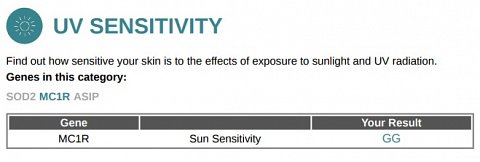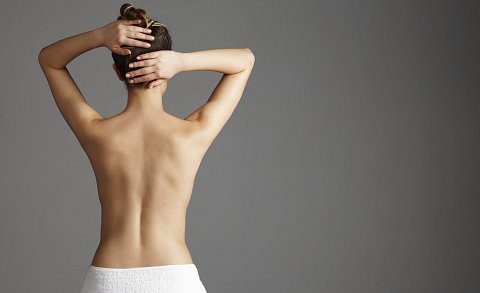-
BEAUTY
review on January 17, 2018
by Ellen Hinkley

At a Glance
Summary
The BEAUTY test from ORIG3N was more than just a fun look at the characteristics of my skin. I was surprised by some of the results, but the explanations helped me to understand why I’d received those that I did. I also appreciated the recommendations and took away advice that I found easy to implement, despite the fact that it varied a bit in specificity, from result to result.
Overall, I think that the BEAUTY test provides a great basis for better understanding of your skin and the factors that can impact its health. I’d recommend it to those looking for insights into their skin and who are happy to use the advice to develop their own care plan, or even just to implement some small changes to improve skin health.
Full Review
ORIG3N, a company based in Boston, USA, was founded by Robin Smith and Kate Blanchard in 2014. Its focus on helping to promote and develop personalized approaches to healthcare is demonstrated in both its DNA tests and its research into stem cell treatments. The company has since developed a range of DNA tests allowing consumers to gain insights into their own health and wellbeing. In addition to those primarily focused on nutrition and fitness, ORIG3N’s tests report on behavior, child development, ‘superhero’ traits and in the case of the BEAUTY test, skin health.I take good care of my skin, but was interested to see whether my DNA would reveal any insights that would help me to develop a more personalized approach to maintaining my skin health.
Product Expectations
I was really impressed with the amount of information available on ORIG3N’s website. The BEAUTY test had its own product page, which included the number of genes that would be analyzed, the categories that the results would cover (‘Appearance and Skin Health’, ‘Aging’, ‘Elasticity’ and ‘UV Sensitivity’) and even the exact names of the genes that would be examined for each of these categories. I thought this provided an excellent overview of what I could expect from the results.
I was also given a preview of what to expect from the test itself, from pictures of the kit, its contents and even the format of the results, shown on an iPhone. These all looked professional and I could see from the kit that I’d have to use a cheek swab. More information about the process was provided on a ‘How it works’ page. This included more images of the kit, and straightforward steps to follow during the process. I was impressed to see that there was a link to the instructions, meaning I could view details of the sampling procedure before purchasing. This helped to reassure me that it really would be “No spit. No mess. Just swab and send.”, as ORIG3N described.
Ordering Experience
When ordering the test, all I had to enter was my email address, the address I wanted the kit sent to, and my payment information. There were lots of options in terms of which card I could use to pay, and I was pleased to see that shipping was free. The choice of FedEx two day or next day delivery was also offered, for an extra fee. I could opt to save this information for a faster checkout process if I wanted to purchase another test later on.
A small notice informed me that by continuing with my purchase, I agreed with ORIG3N’s Terms and Conditions and Privacy Policy. These were written in a straightforward way and I was impressed with how clearly the Privacy Policy stated that “users are the sole owners of their genetic information” and that ORIG3N wouldn’t use it for anything other than to provide the service I’d requested, unless I provided explicit consent.
I was sent an email confirming that my order had been processed and received the kit soon afterwards. It was just like the one I’d seen on the website, and I thought it would have made a great gift. Taking the sample was as simple as the instructions on the site had suggested and I was able to send it back to the lab with no problems, using the pre-paid shipping that had been included.
The Results
I received two further emails from ORIG3N, one informing me that my sample had reached the lab, and another, around a week later, notifying me that my results were ready. This was a pleasant surprise, as the website had advised that my report would likely take around four weeks. I was able to access it via the account I’d set up when registering my kit. When I logged in, I was shown a dashboard of all ORIG3N’s tests, with the ones I’d taken lit up and the rest greyed out. I clicked on BEAUTY and was shown four boxes with images representing the different categories (shown below).

The four categories of results.
I thought this looked professional and was excited to explore them.
There was also a link allowing me to download a PDF version of my report. This was a lot simpler in format, but it was good to have an offline copy of my results. The front page is shown below.

The front page of the PDF version of my report.
Results Section: Skin Aging
The first section of the report was called ‘Skin Aging’ and included five results: ‘Sugar Induced Aging’, ‘Skin Protection’, ‘Antioxidant Enzymes’, ‘Skin Renewal’ and ‘Photo Aging’. My result for each was highlighted with one of three possibilities, ‘Adapt’, ‘Normal’ and ‘Gifted’ (shown below).

Some of my Skin Aging results.
Not all results included one of each of these possibilities. For example, in my ‘Photo Aging’ one, two of the possible results were ‘Normal’ and one was ‘Gifted’, with no ‘Adapt’ option. I wasn’t sure why this was, and, unfortunately, it wasn’t explained.
I was happy to see that I had no ‘Adapt’ results and that two of them were ‘Gifted’. I was interested to find out more about what this might mean for my skin, so clicked them to read more. Each result was accompanied by an explanation, split into two parts. Looking at Photo Aging, I read that I was part of only 10% of the population with this result, and that photo aging basically meant aging due to light, mainly from the sun.
I was advised that even though I wasn’t at an elevated risk of photo aging, I should still take precautions to prevent it. Although no specific recommendations were given, information, such as that UV could still get through clouds and could sometimes even be stronger on cloudy days, was helpful in developing my own precautions.
The second part of the explanation came under the heading ‘Comments’. This section focused less on the physical signs of photo aging and more on its association to the gene that had been analyzed. I felt that this was explained at just the right level, and found the information really interesting.
Beneath this, there was a list of references to the full scientific studies, meaning I could explore further if I wanted to.
Each result was formatted in this way, though I was happy to find that, for my ‘Normal’ results, the recommendations were much more specific. For example, I was advised to use seasonings such as cinnamon, cloves, ginger, garlic, oregano, and allspice rather than things like corn syrup, to reduce sugar induced aging.
Results Section: Skin Elasticity
The next section I looked at was Skin Elasticity. This was the aspect of skin health that I associated most with aging, so was particularly interested in these results. There were four included in this section, ‘Stretch Marks’, ‘Cellulite’, ‘Collagen Breakdown’ and ‘Skin Wrinkling’. Unfortunately, my Cellulite result was ‘Adapt’. Reading the explanation, I was slightly reassured to find out that I was in an 80% majority of people that had this result, though this didn’t change the fact that I was more at risk of having cellulite, which I have noticed, despite being a healthy weight.
Luckily, there were several recommendations about how to reduce the likelihood of getting it. These were helpfully specific, and I was surprised (but happy) to see that one of them was to eat more gelatin, which I’ve only ever seen as an ingredient in sweets and puddings!
The rest of my results came back as ‘Normal’, meaning that my skin wrinkling would be “age-appropriate”, I had an average susceptibility to stretch marks and an average rate of collagen breakdown. I was a bit confused by the fact that some of the results had asterisks instead of letters (e.g. my Collagen Breakdown result was ‘*G’) and unfortunately nothing explained what this meant. Something called an ‘insertion genotype’, was mentioned in the description, which I guessed might have something to do with it, but couldn’t be sure.
Results Section: Appearance and Skin Health
The third section was the largest, containing six results in total. These covered hair as well as skin characteristics, and included ‘Skin Hydration’, ‘Complexion’, ‘Thick Hair’, ‘Hair Greying’, ‘Itchy Skin’ and ‘Monobrow’. The first three of these results were ‘Adapt’, but I was pleased to find that as I scrolled down the last three included two ‘Normal’ results and one ‘Gifted’ one.
I looked at the last of them first, as I was intrigued about what having a ‘Gifted’ Monobrow result actually meant. I read that the variant of the PAX3 gene I have is associated with a lower than average chance of developing a monobrow, which was a relief! I was fascinated to read that, as well as this specific characteristic, the PAX3 gene played a wider role in defining facial features, including ear and eye development.
My Thick Hair result (Adapt) surprised me, as I read that according to my DNA I was more likely to have thinner hair. I would class my hair as being pretty thick, but guessed that there may be other genes that hadn’t been tested that also have an impact on the thickness of my hair.
Results Section: UV Sensitivity
The final section of the report looked at results related to UV Sensitivity, and was made up of three results. I decided to look back at the PDF report for information on this section. This version seemed to provide the same information as the online one had, but it was all in one place, and rather than the ‘Adapt’, ‘Normal’ and ‘Gifted’ labels, the letters were presented as the main result (shown below).

My PDF Sun Sensitivity result.
Like the results in the online version, explanations of each possible result were included, and this is where I read whether my result was considered ‘Adapt’, ‘Normal’ or ‘Gifted’. I was surprised to read that my Sun Sensitivity result was ‘Gifted’ as I am quite pale and tend to burn quite easily. However, I read that as well as tanning, this result was associated with freckles, which I do get a lot of in the sun. I also saw that my ‘Suntan’ result was ‘Normal’, which seemed more likely.
Summary
The BEAUTY test from ORIG3N was more than just a fun look at the characteristics of my skin. I was surprised by some of the results, but the explanations helped me to understand why I’d received those that I did. I also appreciated the recommendations and took away advice that I found easy to implement, despite the fact that it varied a bit in specificity, from result to result.
Overall, I think that the BEAUTY test provides a great basis for better understanding of your skin and the factors that can impact its health. I’d recommend it to those looking for insights into their skin and who are happy to use the advice to develop their own care plan, or even just to implement some small changes to improve skin health.
Please note that we were invited to take this test free of charge


